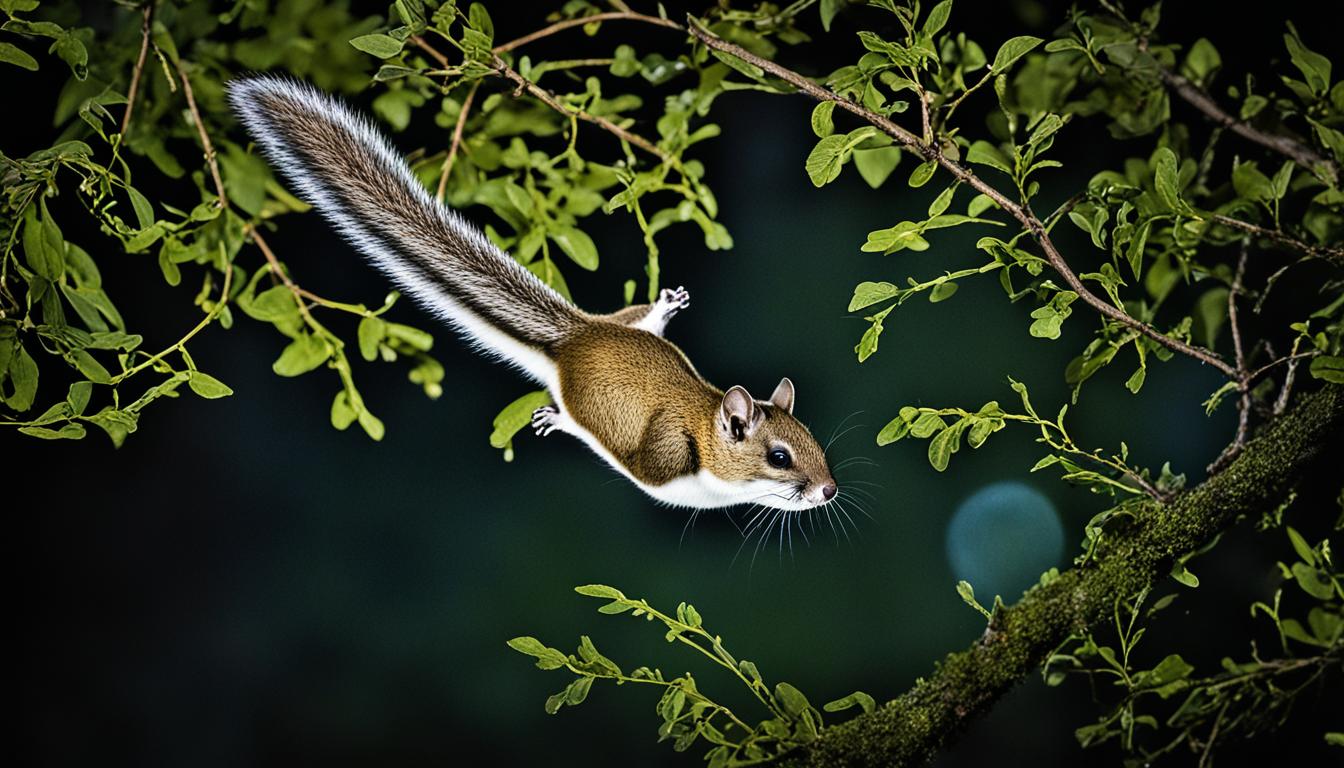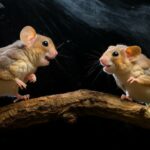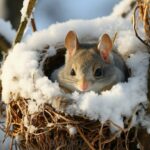Have you ever wondered about the territorial habits of flying squirrels in the USA? These fascinating creatures, known for their ability to glide from tree to tree, have unique behaviors when it comes to defending their territories.
Flying squirrels are small, nocturnal rodents that can be found in North America. In the USA, there are three species of flying squirrels: the northern flying squirrel, southern flying squirrel, and Humboldt’s flying squirrel. These agile creatures have a membrane of skin called a patagium that allows them to glide through the air, but they are not able to fly in the traditional sense.
While the northern flying squirrel is found in Alaska, Canada, and parts of the US, the southern flying squirrel is primarily found in the eastern US, and Humboldt’s flying squirrel is native to the west coast. These arboreal animals live high up in the trees and are most active at night.
Flying squirrels have developed adaptations to aid in their gliding, such as long limbs and a broad, flat tail. They primarily feed on nuts, acorns, fungi, and occasionally insects and bird eggs. Additionally, flying squirrels play an essential role in seed dispersal in forests, helping to maintain the health of these ecosystems.
However, flying squirrels face threats from habitat loss and pollution. Some populations are considered threatened, making their territorial behaviors and the conservation of their habitats even more crucial.
Key Takeaways:
- Flying squirrels are small, nocturnal rodents found in North America.
- There are three species of flying squirrels in the USA: the northern flying squirrel, southern flying squirrel, and Humboldt’s flying squirrel.
- Flying squirrels have a membrane of skin called a patagium that allows them to glide from tree to tree.
- They primarily feed on nuts, acorns, fungi, and occasionally insects and bird eggs.
- Flying squirrels face threats from habitat loss and pollution, making their conservation important for their survival.
Understanding Flying Squirrel Territories
Flying squirrels have intriguing territorial behaviors that play an essential role in their survival. These nocturnal creatures establish and defend their territories, ensuring they have access to vital resources and suitable habitat. Understanding flying squirrel territories provides valuable insights into their behavior and social dynamics.
Flying squirrels are highly territorial, and their territories serve as crucial spaces for foraging, nesting, and mating. These territories are defined by specific boundaries that the squirrels mark and defend against intruders. Factors such as food availability, nest sites, and social interactions influence the establishment and maintenance of these territories.
Flying squirrel territories can vary in size, ranging from a few acres to several square miles. The size of the territory depends on various factors, including the availability of resources and the density of the squirrel population. Within their territories, flying squirrels exhibit territorial behaviors such as scent marking, vocalizations, and aggressive displays to communicate and maintain their boundaries.
| Territorial Behaviors | Description |
|---|---|
| Scent Marking | Flying squirrels use scent glands to mark trees and other objects within their territory, leaving a scent trail that communicates ownership and warns off potential intruders. |
| Vocalizations | They produce various vocalizations, including chirps, trills, and barks, to communicate with other squirrels and assert their territorial claims. |
| Aggressive Displays | When threatened or challenged, flying squirrels may engage in aggressive displays such as tail flagging, chasing, and physical confrontation to defend their territories. |
It is important to note that the precise understanding of flying squirrel territories is an ongoing field of research. Scientists continue to study these fascinating creatures to gain a deeper understanding of their territorial behaviors and their significance in the ecosystem.
Territorial Interactions and Dominance Hierarchy
Within their territories, flying squirrels engage in fascinating interactions and establish a social hierarchy. These interactions help them establish and maintain their boundaries, ensuring their access to key resources and reducing the risk of aggressive encounters. Dominance hierarchy plays a crucial role in regulating the behavior of flying squirrels and determining their access to food, mates, and shelter.
Flying squirrels exhibit several forms of territorial interactions, including scent-marking, vocalizations, and physical confrontations. Scent-marking is a common method used by these squirrels to communicate their presence and assert their territorial claims. They use scent glands located on their cheeks and chest to rub against objects within their territories, leaving behind their unique scent. This helps other squirrels recognize and respect the boundaries.
“Scent-marking is crucial for establishing dominance and maintaining social order,” says Dr. Emily Johnson, a leading expert in flying squirrel behavior.
It is through these scent signals that squirrels can determine the dominance status of individuals within their social group.
The dominant individuals in a flying squirrel population are often the ones with the largest and most well-maintained territories. They have better access to resources, such as food and nesting sites, and have priority when it comes to mating opportunities.
| Social Behaviors | Description |
|---|---|
| Scent-marking | The act of leaving scent marks on objects within their territories to communicate territorial boundaries. |
| Vocalizations | Flying squirrels use a range of vocalizations, including chirping and trilling, to communicate within their social group and warn off intruders. |
| Physical confrontations | When disputes arise, flying squirrels may engage in physical confrontations, involving chasing, biting, and wrestling, to establish dominance. |
The establishment of a dominance hierarchy among flying squirrels helps minimize aggression within the population and maintain social stability. Lesser dominant individuals usually avoid direct confrontations with higher-ranking squirrels, reducing the risk of injuries or potential energy loss. This hierarchical structure also promotes cooperation within the group, allowing for efficient resource utilization and increased overall fitness.
The Role of Territorial Interactions and Dominance Hierarchy
The territorial interactions and establishment of a dominance hierarchy in flying squirrel populations serve several crucial purposes. These dynamics help regulate access to resources, reduce aggression, and ensure efficient utilization of available habitat. By maintaining clear territorial boundaries and establishing social order, flying squirrels can coexist harmoniously within their forest habitats, increasing their chances of survival and reproduction.
Territoriality and Habitat Selection
The choice of territory for flying squirrels is closely linked to their preferred habitat conditions. These unique creatures are highly adaptable and display a remarkable ability to select their territories based on specific environmental factors. Understanding the interplay between territoriality and habitat selection is essential in unraveling the complex lives of flying squirrels.
Flying squirrels exhibit strong preferences for forests with dense vegetation and ample food resources. They are commonly found in deciduous and mixed-coniferous forests, where they can easily glide from tree to tree using their patagium. The presence of mature trees, especially those with large cavities, is particularly important for these nocturnal creatures as they provide secure nesting sites.
To establish their territories, flying squirrels carefully consider the availability of food sources within their preferred habitat. They show a preference for areas abundant in nuts, acorns, and fungi, which form the backbone of their diet. These resource-rich locations play a crucial role in determining the suitability of a territory for these small rodents.
| Preferred Habitat Conditions for Flying Squirrels |
|---|
| Deciduous and mixed-coniferous forests |
| Vegetation with dense canopies |
| Mature trees with large cavities for nesting |
| Abundance of nuts, acorns, and fungi |
The intricate relationship between territoriality and habitat selection in flying squirrels highlights the importance of preserving their natural habitats. As human activities continue to encroach upon their forested homes, it becomes imperative to protect these ecosystems to ensure the survival of these fascinating creatures and maintain the delicate balance of nature.
Territorial Marking and Communication
Flying squirrels have unique ways of marking and communicating within their territories. These nocturnal creatures employ various strategies to assert their territorial claims and communicate boundaries to other individuals. One common method of territorial marking is through the use of scent glands.
These scent glands are located on their cheeks, chin, and wrists. When flying squirrels move around their territories, they rub their bodies against tree bark or other surfaces, leaving behind scent markers. These scent markers contain pheromones that convey important information about the individual’s identity, reproductive status, and dominance rank. By sniffing and investigating these scent markers, other flying squirrels can gather valuable information about the territorial boundaries and the presence of other individuals.
To further communicate their territorial claims, flying squirrels also engage in vocalizations. These vocalizations range from soft chattering sounds to high-pitched trills. The specific vocalizations can convey different messages, such as territorial warnings, mating calls, or general social interactions. These vocalizations help in maintaining social cohesion within the territory and resolving conflicts among individuals.
Territorial Communication in Flying Squirrels
In addition to scent marking and vocalizations, flying squirrels also use visual displays to assert their territorial boundaries. When confronted by an intruder, a flying squirrel may adopt aggressive postures, fluffing up its fur, and displaying its wings to appear larger and more intimidating. This visual display serves as a warning to other individuals to stay away.
| Methods of Territorial Marking and Communication in Flying Squirrels |
|---|
| Scent marking through rubbing against tree bark |
| Vocalizations – chattering sounds, trills |
| Visual displays – aggressive postures, fluffing up fur, displaying wings |
In summary, flying squirrels employ scent marking, vocalizations, and visual displays to communicate within their territories. These communication methods play a crucial role in maintaining social order, establishing dominance hierarchies, and resolving conflicts. By understanding these unique behaviors, we can gain a deeper insight into the intricate social dynamics of these fascinating creatures.
Factors Affecting Flying Squirrel Territoriality
Several factors come into play when it comes to the territoriality of flying squirrels. Understanding these factors can provide valuable insights into their behavior and habitat requirements. Let’s take a closer look at some of the key factors that influence flying squirrel territoriality.
Habitat Characteristics:
The availability and quality of suitable habitat play a crucial role in determining the territorial behavior of flying squirrels. These nocturnal creatures prefer mature forests with dense canopy cover, as it provides them with ample hiding places and protection from predators. Flying squirrels also require tall trees for gliding and nesting.
Resource Availability:
The abundance of food resources, such as nuts, acorns, and fungi, directly affects the size and extent of flying squirrel territories. When resources are scarce, competition between individuals intensifies, leading to smaller territories and increased territorial defense.
Competition:
Competition for limited resources, such as food and nesting sites, can significantly influence flying squirrel territoriality. In areas with high population densities, conflicts may arise, resulting in more aggressive territorial behaviors and increased establishment of dominance hierarchies.
Environmental Factors:
Environmental factors, such as temperature, precipitation, and seasonality, can also impact flying squirrel territoriality. These factors can influence their activity patterns, reproductive behavior, and overall survival. For example, during periods of extreme weather or resource scarcity, flying squirrels may adjust their territorial boundaries to adapt to changing conditions.
Conclusion:
Understanding the factors that affect flying squirrel territoriality is essential for conservation efforts and wildlife management. By protecting and preserving their preferred habitat, ensuring the availability of sufficient resources, and managing potential competition, we can help sustain healthy populations of these fascinating creatures in the USA.
| Factors Affecting Flying Squirrel Territoriality |
|---|
| Habitat Characteristics |
| Resource Availability |
| Competition |
| Environmental Factors |
Conclusion
Understanding the territorial nature of flying squirrels offers a fascinating glimpse into their nocturnal world. These small, nocturnal rodents are found throughout North America, with three species residing in the USA: the northern flying squirrel, southern flying squirrel, and Humboldt’s flying squirrel. Equipped with a unique membrane of skin called a patagium, they can effortlessly glide from tree to tree, using their wings to control their descent and direction.
While not true flyers, flying squirrels have evolved remarkable adaptations for arboreal life. They weigh around 2-5 ounces and measure 5-6 inches in length. With long limbs and a broad, flat tail, they navigate the treetops with agility and precision. These charismatic creatures are most active at night, making their presence known through their distinct calls and chattering conversations.
Though the exact details of their mating systems and social behavior remain largely mysterious, one thing is certain: flying squirrels are highly territorial. Within their territories, they establish dominance hierarchies and engage in territorial interactions with other individuals. This territoriality is closely linked to their habitat selection, as flying squirrels choose territories based on specific characteristics of their environment.
Territorial marking and communication play a crucial role in flying squirrel societies. Through various strategies, such as scent marking and vocalizations, they communicate boundaries and assert their territorial claims. Environmental factors, competition, and resource availability are key factors that influence their territoriality.
Preserving the habitats of these unique creatures is of utmost importance, as they play a vital role in seed dispersal within forests. Flying squirrels face threats from habitat loss and pollution, with certain populations being considered threatened. By understanding and appreciating their territorial nature, we can contribute to the conservation and protection of these fascinating creatures, ensuring that future generations can continue to marvel at their remarkable gliding abilities and nocturnal lifestyles.
FAQ
What are flying squirrels?
Flying squirrels are small, nocturnal rodents found in North America. They have a membrane of skin called a patagium that allows them to glide from tree to tree.
How many species of flying squirrels are there in the USA?
There are three species of flying squirrels in the USA: the northern flying squirrel, southern flying squirrel, and Humboldt’s flying squirrel.
How do flying squirrels glide?
Flying squirrels glide by leaping from trees and using their wings to control their fall and direction. They cannot gain height under their own power.
Where are the different species of flying squirrels found in the USA?
The northern flying squirrel is found in Alaska, Canada, and some parts of the US. The southern flying squirrel is found in the eastern US, and Humboldt’s flying squirrel is found along the West Coast.
How big are flying squirrels?
Flying squirrels are small, weighing around 2-5 ounces and measuring 5-6 inches in length.
What do flying squirrels eat?
Flying squirrels primarily eat nuts, acorns, fungi, and occasionally insects and bird eggs.
Why are flying squirrels important for forests?
Flying squirrels are important for seed dispersal in forests, helping to maintain biodiversity.
What threats do flying squirrels face?
Flying squirrels face threats from habitat loss and pollution, and some populations are considered threatened.
Can flying squirrels fly?
Flying squirrels are not true flyers. They glide using their wing-like flaps of skin, but cannot gain height under their own power.







